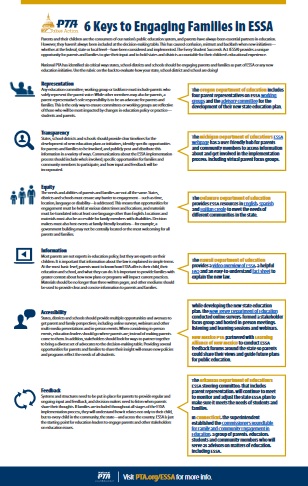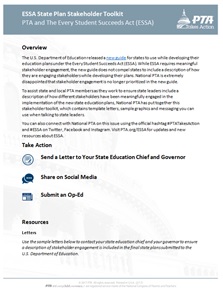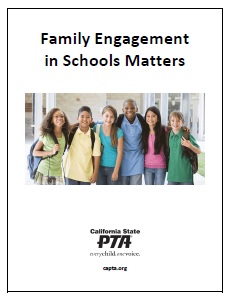The California Department of Education, in collaboration with Smarter Balanced and Educational Testing Service (ETS), have launched two new websites for parents called “Starting Smarter” for the California Assessment of Student Performance and Progress (CAASPP) and the English Language Proficiency Assessment for California (ELPAC).
These family-focused websites provide resources to facilitate parents’/guardians’ understanding of the scores presented on their child’s Student Score Reports. Using these websites, families can learn more about the performance areas in each subject and grade, see sample test questions, prepare for parent-teacher conferences with a useful downloadable guide, and access high-quality resources to support learning at home. The websites are also available in Spanish.
Visit ca.startingsmarter.org and elpac.startingsmarter.org to learn more.
 Parents and their children are the consumers of our nation’s public education system, and parents have always been essential partners in education. However, they haven’t always been included at the decision-making table. This has caused confusion, mistrust and backlash when new initiatives — whether at the federal, state or local level—have been considered and implemented.
Parents and their children are the consumers of our nation’s public education system, and parents have always been essential partners in education. However, they haven’t always been included at the decision-making table. This has caused confusion, mistrust and backlash when new initiatives — whether at the federal, state or local level—have been considered and implemented.
The Every Student Succeeds Act (ESSA) provides a unique opportunity for parents and families to give their input and to hold states and districts accountable for their children’s educational experience.
National PTA has identified six critical ways states, school districts and schools should be engaging parents and families as part of ESSA or any new education initiative. Use the rubric on the back to evaluate how your state, school district and school are doing!
 National PTA has a new toolkit to assist state, local PTAs and their PTA members to ensure state leaders include how they have engaged and meaningfully consulted different stakeholders in the implementation of the new state education plans. The toolkit includes:
National PTA has a new toolkit to assist state, local PTAs and their PTA members to ensure state leaders include how they have engaged and meaningfully consulted different stakeholders in the implementation of the new state education plans. The toolkit includes:
- Sample social media messages
- Graphics
- Letters
Download National PTA’s ESSA Stakeholder Toolkit.
 As a critical component of the new Local Control Funding Formula (LCFF), every school district must engage parents and the community to create a Local Control and Accountability Plan (LCAP). The LCAP is intended to be a comprehensive planning tool to help all students succeed. Parents, families and community members can have a voice in the development and evaluation of their school districts’ LCAP throughout the year.
As a critical component of the new Local Control Funding Formula (LCFF), every school district must engage parents and the community to create a Local Control and Accountability Plan (LCAP). The LCAP is intended to be a comprehensive planning tool to help all students succeed. Parents, families and community members can have a voice in the development and evaluation of their school districts’ LCAP throughout the year.
- FALL — Educate
- WINTER — Review
- SPRING — Engage
- SUMMER — Reflect
Download the flier in multiple languages:
The California Mathematics Placement Act of 2015 requires school districts that serve pupils entering grade nine and that have not already done so to adopt “a fair, objective, and transparent mathematics placement policy” before the beginning of the 2016–17 school year. The mathematics placement policy must be adopted in a regularly scheduled public meeting.
This PTA supported law, SB 359 (Mitchell), addresses the math misplacement of students — especially students of color — as they enter high school. Correct math placement in ninth grade is crucial for educational success. Misplacement can result in pupils being less competitive for college admissions, including at the California State University and University of California.
Important Tip for PTA Leaders
 At your next school board meeting:
At your next school board meeting:
- Ask how your school district is implementing this new law
- Share the sample school board policies and resources below
- Help make sure the students in your local schools benefit from the California Mathematics Placement Act of 2015.
Resources for School Districts
The Silicon Valley Community Foundation, a sponsor of the bill, has put together resources to help school boards and communities implement the law and address the issue of math misplacement.
Digging Deeper
A letter from Superintendent of Public Instruction Tom Torlakson to County and District Superintendents and Charter School Administrators outlines the requirements of the new law:
“The mathematics placement policy for pupils entering grade nine must meet the following requirements:
- Systematically takes multiple objective academic measures of pupil performance into consideration;
- Includes at least one placement checkpoint within the first month of the school year to ensure accurate placement and to permit reevaluation of individual student progress;
- Requires an annual examination of pupil placement data to ensure that students are not held back in a disproportionate manner on the basis of their race, ethnicity, gender, or socioeconomic background;
- Requires a report on the results of the annual examination by the local educational agency to its governing board or body;
- Offers clear and timely recourse for each pupil and his or her parent or legal guardian who questions the student’s placement; and
- For non-unified school districts, addresses the consistency of placement policies between elementary and high school districts.”
The math placement policy must be posted on the district web site.
It’s never too early – or too late – to plan for your child’s college future and to develop your college-savings road map! California State PTA and ScholarShare, California’s 529 College Savings Plan, are teaming up to raise awareness about the importance of saving for college.
 Here are a few steps you can take to develop a college savings road map for your child:
Here are a few steps you can take to develop a college savings road map for your child:
- Start Small and Early — The task of saving for college can be overwhelming, but the sooner you get started, the greater the likelihood that your child will go to college and have the funds to pay for it. Various studies show that a child with a college savings account is 6 to 7 times more likely to attend college. The key is to get started.
- Review Your Finances — Saving for college can be daunting. That’s why it’s important to take a careful look at your finances and identify any available funds that you can regularly contribute to your college savings. No contribution is too small. Every little bit helps.
- Define Your Goal — Paying for 100 percent of a child’s future college expenses may not be a realistic goal for some parents. Fortunately, the share you save is only a part of a larger strategy to help pay for college. Define a goal that makes sense for your family and plan accordingly.
- Understand Your 529 Plan — A 529 plan is a state-sponsored, tax-advantaged savings plan designed to help families save for college. The State of California offers the ScholarShare College Savings Plan. In addition to the many benefits, you can open a ScholarShare account with just $25. Visit scholarshare.com to learn more.
LEARN MORE
This Family Engagement Guide contains information on why family engagement in schools matters, how to grow family-school partnerships to enhance student achievement and ways to support student success and learning at home. Throughout the resource, the word “parent” refers to parents, guardians and caregivers who have the primary responsibility for raising children and are involved in their development, learning and growth.
 Download:
Download:
The power of civics education was front and center at our recent convention when California State PTA Past President Carol Kocivar sat down to interview Chief Justice of California Hon. Tani G. Cantil-Sakauye. Take a look!
Revitalizing K-12 civic learning in California will be a long process that will require strong and enduring commitments, and it is going to take effort from everyone. While we seek to implement the policy changes recommended here, we can each take action immediately to improve civic learning opportunities for all students.
As we chart the course for K-12 education in the 21st century, we must work together to bring quality civic learning opportunities to all children in California. Together, we can realize California’s civic promise and ensure that our schools fulfill their vital civic mission.
If we want to reach all children, policy has to set the context, but we do not have to wait for new policies to be in place before we take action to improve civic learning in California. There are many things we can do right away. The following suggestions come from hundreds of people like you.
FAMILIES CAN
- Talk to their children about what they are learning in civics.
- Vote, if eligible, and take their child with them.
- Read the news and talk about news and politics with their children.
- Attend public meetings and tell their children about what happens there.
- Advocate for civic learning in schools.
PTAs CAN
- Start a PTA award for outstanding civics projects.
- Organize a “speakers bureau” for presenters such as local city council members and legislators on current events topics.
- Organize volunteers to help with civics projects.
- Host candidate forums and provide voter registration for parents.
- Encourage families to vote.
- Advocate for civic learning in school.
Learn more in the report.
 Parents and their children are the consumers of our nation’s public education system, and parents have always been essential partners in education. However, they haven’t always been included at the decision-making table. This has caused confusion, mistrust and backlash when new initiatives — whether at the federal, state or local level—have been considered and implemented.
Parents and their children are the consumers of our nation’s public education system, and parents have always been essential partners in education. However, they haven’t always been included at the decision-making table. This has caused confusion, mistrust and backlash when new initiatives — whether at the federal, state or local level—have been considered and implemented. National PTA has a new toolkit to assist state, local PTAs and their PTA members to ensure state leaders include how they have engaged and meaningfully consulted different stakeholders in the implementation of the new state education plans. The toolkit includes:
National PTA has a new toolkit to assist state, local PTAs and their PTA members to ensure state leaders include how they have engaged and meaningfully consulted different stakeholders in the implementation of the new state education plans. The toolkit includes: As a critical component of the new
As a critical component of the new  At your next school board meeting:
At your next school board meeting: Here are a few steps you can take to develop a college savings road map for your child:
Here are a few steps you can take to develop a college savings road map for your child: Download:
Download: